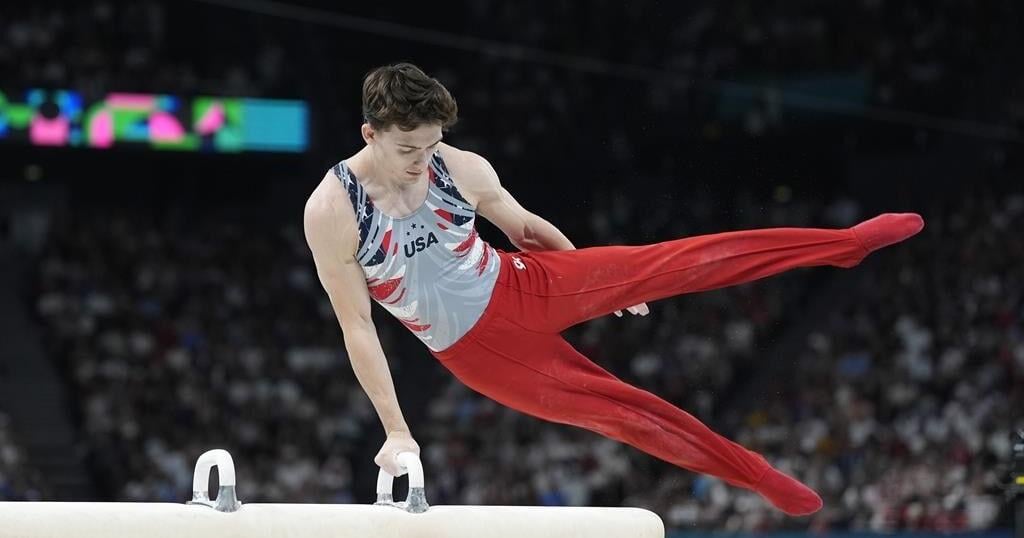PARIS (AP) — Sam Mikulak pulled Stephen Nedoroscik close and tasked the American pommel horse specialist with the impossible.
The U.S. men’s gymnastics team’s first Olympic medal in 16 years a solitary routine away, Mikulak told the pommel horse specialist that he didn’t need to go all out. That 80% would be good enough, even though Mikulak knew full well that Nedoroscik never does anything — from his sport to solving a Rubik’s Cube — at 80%.
“You have to trick yourself,” said Mikulak, a three-time Olympian turned coach. “You’ve got to make sure you don’t let all the noise get into your head.”
That usually isn’t a problem for the 25-year-old from Worcester, Massachusetts. It takes a certain type of single-mindedness to make the choices Nedoroscik has made for the last decade, when he essentially decided to dedicate himself to a single pursuit, focusing on an event that has long been a weakness for the U.S. men’s national team program.
Yes, there is monotony involved. How could there not be?
“I don’t know how I don’t lose my mind,” Nedoroscik said before the Games. “But every day I go into the gym and there’s still something to do. There’s still something to improve.”
Not anymore.
Proving a point
He drilled his set during qualifying on Saturday to earn a spot on the event finals later in the Games. But Monday night, things were different. Teammates Frederick Richard, Brody Malone, Paul Juda and Asher Hong had put together 17 straight routines without a miss, putting the Americans in position to reach the medal stand for the first time since 2008 in Beijing.
While Nedoroscik had some wiggle room — the U.S. had a fairly healthy lead after Juda and Malone hit their sets before Nedoroscik saluted the judges — he also didn’t want to merely hold on. He wanted to prove a point.
Not just to himself, but to those who wondered if he deserved to be there in the first place.
What followed were 45 seconds of sublime brilliance, with Nedoroscik’s hands traveling from one end of the horse to the other, his legs swooping this way, then that.
A few feet away, his four teammates — and the sizable contingent of US fans inside Bercy Arena — roared as a medal that seemed distant for a program that had finished a distant fifth in each of its last three trips under the rings — drew closer.
By the time Nedoroscik neared his dismount, he knew his job was complete. The celebration began before his feet even hit the mat.
All those years, all those reps, both physical and mental, all the difficult times when he wondered whether to keep going, all the quirks he’s developed along the way — from the non-prescription goggles he sometimes rocks to the chef’s kiss to the camera he occasionally makes — led up to that moment.
And he did not miss, delivering “the exclamation point” with a 14.866 to finish off a performance the U.S. men’s program hopes provides serious momentum heading into the 2028 Games in Los Angeles.
“I kind of in that moment was like, ‘All right, let’s run it back and let’s go out there and do our thing,’” Nedoroscik said.
Filling a critical gap
A “thing” that has long been a sore spot for the U.S. in major international competition. The 2012 Olympic team topped qualifying. Then they led off on pommel horse in the finals and saw their medal hopes vanish one mistake at a time.
Nedoroscik understood the history. It’s one of the reasons he gravitated toward pommels. Another is the fact that it requires many things — stamina, strength and creativity chief among them — that he has in spades, particularly that last one.
He describes himself as a “late bloomer” on the event. Those early struggles only helped him press forward.
“Running into trouble on the apparatus early on taught me how to fight, how to stay on, how to really go for that routine,” he said. “And I think that that has stuck with me throughout.”
Unlike other events, which are painstakingly laid out and practiced on end for months if not years, pommel horse allows gymnasts to color outside the lines and make things up as they go on. Miss an element here? Well, maybe you can make it up trying something else later in the routine.
He says the end result is the feeling of “flying through the air,” though it’s more akin to levitation.
More work to be done
Nedoroscik will soar into the event finals Saturday with a chance to put another medal in his carry-on before he heads home. His 15.200 qualifying score tied Ireland’s Rhys McClenaghan for the tops among the eight finalists.
He is ready to ride the wave as far as it will take him. Yet whatever happens on Saturday or for the rest of his life for that matter, it will be difficult to top Monday night, when the guy with the curly hair and the glasses that made him the kind of social media sensation only the Olympics provides struck a blow for his sport, his teammates and himself.
“I’m really proud of these guys,” he said while sitting alongside the group that became U.S. men’s gymnastics royalty. “I love you boys.”
___
AP Summer Olympics:

























